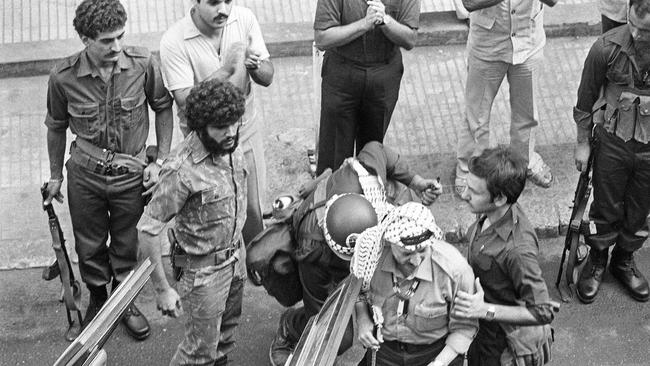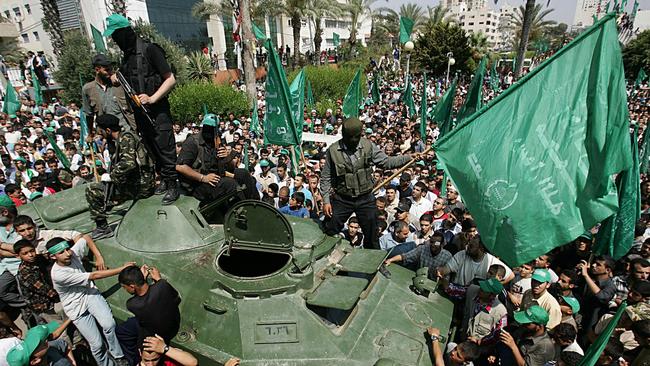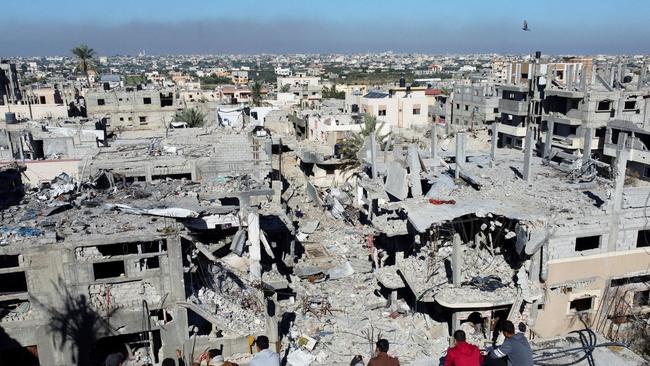Israel considers how to remove threat of Hamas fighters in Gaza
US and Israeli officials, citing the deal that let Palestinian leader Yasser Arafat and thousands of fighters flee Beirut, discuss the idea of providing some militants with an exit strategy from Gaza.

As Israeli forces prepare for a renewed offensive targeting Hamas’s top leaders in the Gaza Strip, Israeli military and political leaders are confronting the challenge of what to do about the thousands of fighters that represent the group’s power base.
To address that challenge, some Israeli and US officials are discussing the idea of expelling thousands of lower-level militants from the Palestinian enclave as a way to shorten the war. The idea is reminiscent of the US-brokered deal that allowed Palestinian leader Yasser Arafat and thousands of fighters to flee Beirut during Israel’s 1982 siege of the Lebanese capital.
The prospect of expelling Hamas fighters is part of evolving Israeli and American talks about who will run Gaza when the war ends and what can be done to ensure that the territory can never be used to stage another attack on Israel like the one on Oct. 7, the worst in the nation’s history.

One proposal for how to govern a post-Hamas Gaza, developed by the Israeli military’s think tank and viewed by The Wall Street Journal, would start with the creation of what it calls “Hamas-free safe zones” that would be ruled by a new Gaza authority backed by Saudi Arabia and the United Arab Emirates.
Separate US-Israeli discussions about moving Hamas fighters and their families out of the Gaza Strip aim to provide some Hamas fighters with an exit strategy and make it easier to rebuild Gaza once the fighting ends.
As a temporary ceasefire that began Friday continues to hold, there is still no emerging consensus on the fundamental questions that could bring the war to an end. There is no agreement between Israel, the US and Arab nations about who should run Gaza or who would provide daily security for the two million people living there.
Israel and the US are at odds over what role, if any, the West Bank-based Palestinian Authority should play in running Gaza. And there is no road map for what should happen to thousands of Hamas fighters and their families.
One option being discussed by Israel and the US is the proposal to force lower-level fighters to leave the Gaza Strip, to prevent the group – which the US considers to be a terrorist organisation – from regaining power.
Before the war started, Israel estimated that Hamas had about 30,000 fighters in the Gaza Strip. Israel has vowed to kill the top Hamas leaders and any members who took part in the Oct. 7 attacks.
The Israeli military estimates that it has killed thousands of militants since the war began. Determining how to address the large number of surviving Hamas fighters and their families has led officials to consider the Beirut model.

In 1982, Israeli military forces encircled Beirut in an effort to weaken the Palestine Liberation Organization’s power in Lebanon. The two-month siege and extensive Israeli bombing of Beirut created a rift between Israel and the US, which brokered a deal to end the fight with an agreement by Israel to allow Arafat and about 11,000 Palestinian fighters to leave Lebanon for Tunisia.
There has been no recent discussion of allowing top Hamas officials such as Gaza leader Yahya Sinwar and military commander Mohammed Deif to leave Gaza because of their role in planning the Oct. 7 attacks, which Israel says killed 1,200 people, most of them civilians.
Leaving Gaza would be fundamentally different for Palestinian fighters today than leaving Lebanon was in 1982. While the militants were visitors in Beirut, the Gaza Strip is home and part of a hoped-for independent Palestinian state.
One senior Israeli official said it isn’t clear that Hamas fighters would take the option of exile, if offered.
“I don’t see them as rational as the PLO was,” the official said. “It’s a more religious, jihadistic organisation connected to the ideas of Iran.” The official said there was no “practical discussion” of exiling Hamas fighters but said that if Israel left Hamas with no other choice, the option might become possible. Hamas officials didn’t respond to requests for comment.

Some Hamas fighters might be willing to consider the idea if their leadership is killed, said Randa Slim, director of the Conflict Resolution and Track II Dialogues Program at the Middle East Institute. But the idea faces many hurdles that could make it impractical, she said.
The proposal would require support from countries willing to accept the Hamas fighters, whose leaders have found safety in places such as Turkey, Qatar, Iran, Russia and Lebanon. It would have to address the question of whether the fighters would be able to leave with their families. And it would require Hamas to trust Israel to honour whatever commitments it makes in the deal, such as an agreement not to target the militants once they leave Gaza.
“I think it is unrealistic today given the current state of conflict,” Slim said. “But things might evolve in the future.” The military, meanwhile, has developed the separate proposal that envisions the creation of a “Gaza Restoration Authority,” backed by Saudi Arabia and the U.A.E., that would be charged with rebuilding a Hamas-free Gaza Strip.
That proposal is mostly a starting point for discussions that face huge obstacles, including the US position, opposed by Israel, that any post-war government in Gaza should be linked to the Palestinian Authority. It would also require buy-in from Saudi Arabia and the U.A.E. The Israeli military declined to comment on its proposal.

The Wall Street Journal




To join the conversation, please log in. Don't have an account? Register
Join the conversation, you are commenting as Logout